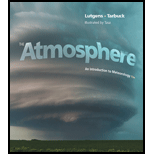
The Atmosphere: An Introduction to Meteorology (13th Edition) (MasteringMeteorology Series)
13th Edition
ISBN: 9780321984623
Author: Frederick K. Lutgens, Edward J. Tarbuck, Dennis G. Tasa
Publisher: PEARSON
expand_more
expand_more
format_list_bulleted
Question
Chapter 6.3, Problem 1CC
To determine
The three forces that combine to direct wind. Also identify what generates wind.
Expert Solution & Answer
Want to see the full answer?
Check out a sample textbook solution
Students have asked these similar questions
Design experiments in UV-Vis to figure the optimal mole ratio of copper (1:1, 2:1, 3:1 and etc)versus ethambutol using all necessary chemicals including dihydrochloride and copper nitrate hemipentahydrate and sodium hydroxide. Show how UV-Vis absorbance and maximum wavelength would change in response
Correct each molecule in the drawing area below so that it has the condensed structure it would have if it were dissolv
a 0.1 M aqueous solution of HCI.
If there are no changes to be made, check the No changes box under the drawing area.
No changes.
HO—CH,—C—CH,—OH
X
5
2
2
2
HO–CH,—CH,—C—CH,—OH
Explanation
Check
Center Accessi
©2025 on
5
C
Make the calculations to prepare 2M H2SO4, from concentrated H2SO4 (98%; density: 1.84 g/mL).
Chapter 6 Solutions
The Atmosphere: An Introduction to Meteorology (13th Edition) (MasteringMeteorology Series)
Ch. 6.1 - Prob. 1CCCh. 6.1 - Prob. 2CCCh. 6.1 - Prob. 3CCCh. 6.1 - Prob. 4CCCh. 6.1 - Prob. 5CCCh. 6.2 - Prob. 1CCCh. 6.2 - Prob. 2CCCh. 6.2 - Prob. 3CCCh. 6.2 - Prob. 4CCCh. 6.2 - Prob. 5CC
Ch. 6.2 - Prob. 6CCCh. 6.3 - Prob. 1CCCh. 6.3 - Prob. 2CCCh. 6.3 - Prob. 3CCCh. 6.3 - Prob. 4CCCh. 6.4 - Prob. 1CCCh. 6.4 - Prob. 2CCCh. 6.4 - Prob. 3CCCh. 6.4 - Prob. 4CCCh. 6.5 - Prob. 1CCCh. 6.5 - Prob. 2CCCh. 6.5 - Prob. 3CCCh. 6.6 - Prob. 1CCCh. 6.6 - Prob. 2CCCh. 6.6 - Prob. 3CCCh. 6 - Prob. 1GSTCh. 6 - Prob. 2GSTCh. 6 - Prob. 3GSTCh. 6 - Prob. 4GSTCh. 6 - Prob. 5GSTCh. 6 - Prob. 6GSTCh. 6 - Prob. 7GSTCh. 6 - Prob. 8GSTCh. 6 - Prob. 9GSTCh. 6 - Prob. 10GSTCh. 6 - Prob. 1PCh. 6 - Prob. 2P
Knowledge Booster
Similar questions
- An electron and a proton are each moving at 755 km/s in perpendicular paths as shown in (Figure 1). At the instant when they are at the positions shown, find the magnitude and direction of the total magnetic field they produce at the origin. Find the magnitude and direction of the magnetic field the electron produces at the location of the proton. Find the magnitude and direction of the total magnetic and electric force that the electron exerts on the proton. Please explain all stepsarrow_forwardH CH3 CH3 b) Write the products of your compound and the following reagents. If the reaction would not work for your compound, write "no reaction" and explain the problem. NaCN H* H₂NNHCH5 H* -à NaBH -à CH2MgBr Cro₁₂ --à H3O+ -à c) Would your compound give a positive Tollen's test? Why or why not?arrow_forwardHomework 4 Chem 204 Dr. Hellwig Consider this compound, which will be referred to as "your compound". a) Name your compound according to the IUPAC system. Include stereochemistry (E/Z/R/S) H CH3 CH3arrow_forward
- What is the mechanism for this?arrow_forward21.50 Determine the combinations of haloalkane(s) and alkoxide(s) that could be used to synthesize the following ethers through Williamson ether synthesis. (a) (c) (d) (e) (f) H₂COarrow_forwardAn electron and a proton are each moving at 755 km/s in perpendicular paths as shown in (Figure 1). At the instant when they are at the positions shown, find the magnitude and direction of the total magnetic field they produce at the origin. Find the magnitude and direction of the magnetic field the electron produces at the location of the proton. Find the magnitude and direction of the total magnetic and electric force that the electron exerts on the proton. Please explain all stepsarrow_forward
- 1. Arrange the following in order of increasing bond energy (lowest bond energy first, highest bond energy last). Provide your rationale. C=C, C-F, C=C, C-N, C-C List the bond order for each example.arrow_forwardWhat is the major enolate formed when treated with LDA? And why that one?arrow_forward4. Calculate the total number of sigma bonds and total number of pi bonds in each of the following compounds. a. HH :D: +1 I H-N-C-C-O-H I H b. HH H Н :N=C-C-C=C-CEC-H :0: total o H-C-H H-C = `C-H I H. 11 H-C = C= CH H total o total π total π 1 Harrow_forward
- 58 64. Rhythm: Clues: Rhythm: Clues: 62 Rhythm QRS Complex Rates PRI Interpretation Rhythm: P wave QRS Complex Rate PRI Interpretation Rhythm: Clues: Rhythm P wave: QRS Complex Rate PRI Interpretation: Rhythm: P wave: QRS Complex: Rate: Interpretation: 67 Rhythm: P wave: QRS Complex: Rate: PRI Interpretation: Rhythm: P wave: QRS Complex: Rate: PRI Interpretation: 68 Rhythm P waves QRS Complex Rate PRI Interpretation Rhythm P wave QRS Complex Rhythm: P wave QRS Complex: Rate PRI Interpretations Rate PRI Interpretationarrow_forwardhelparrow_forward51. 52. 53. Rhythm: Clues: Rhythm: Clues: Rhythm: Clues:arrow_forward
arrow_back_ios
SEE MORE QUESTIONS
arrow_forward_ios